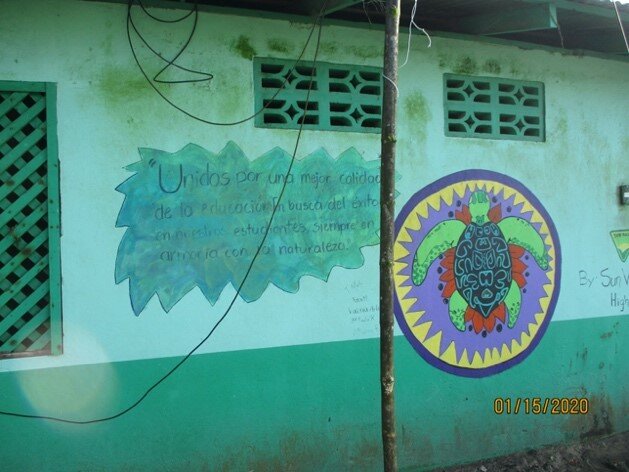Written by Lily Bonasso
In January of 2020, I had the privilege of traveling to Costa Rica with a small group of W&J students as well as Dr. March and Dr. Ternes for a Jay-term course focusing on tropical ecology. In light of the recent travel bans, I have been reflecting on how lucky I am to have gained such an enriching experience before the world was shut down. As part of the Earth Day Fair, I would like to share some important insights that I gained during my short trip to the tropics to highlight what conservation means to their lives.
The Earth is the Earth, and we are just living in it.
In Costa Rica, the sun typically rises before 6 AM. I remember waking up slowly, before my alarm rang, met by soft orange light creeping through the mosquito netting over my bed toward my bleary eyes. As soon as I emerged from my room, I was confronted by a green iguana on the sidewalk. In a country in which over a quarter of the land is protected, it is impossible to go about your day without encountering wildlife. Making our temporary homes on biological field stations, we were rather spoiled in this respect. Costa Rica thrives off of its ecotourism industry. Though there can be harmful effects of ecotourism, such as exposing the wildlife to visitors that may affect their lives, it fosters an attitude of admiration towards the environment. The efforts of the field stations, in protecting vast areas of land and the wildlife that lives within, demonstrate a faith in the function of the planet. We walk through to observe and admire what happens around us. The howler monkeys screech at dawn, a natural alarm clock for the rainforest. The strangler fig chokes out its victim tree, slowly starving it of sunlight and nutrients. The frogs, bugs, and birds make homes in the hollow gaps of the tree. The quetzal swallows the avocado seed and regurgitates it on the ground, ready to grow into a new tree. The sky releases a torrential downpour. And the howler monkeys screech again as the day comes to a close, welcoming the night creatures’ emergence. The Earth is the Earth, and we are just living in it.

Everything is connected, and I mean everything.

As our charismatic and passionate tour guides led us on treks through the rainforest, they taught us about every species we encountered. We learned about flora and fauna alike. What I found the most intriguing thread among each of these guided hikes was the interconnectedness of nature. None of the species that we observed has developed independently from its neighbors. For example, the acacia ants live within holes in the thorns of the bullhorn acacia plant. As payment for housing, the ants provide protection, attacking any predators that dare to challenge the plant. Sloths prefer to sleep in a specific species of tree that has adequate branch spacing and leaf coverage. The fruit of the cacao tree contains bitter seeds that birds and monkeys will spit out, therefore dispersing the seeds for growth. The pochote tree has evolved to grow with bumps on its branches so that monkeys are less inclined to use it as a lounge spot. Immersed in an ecosystem that has been preserved, we were able to observe the intimate ways that each species has adapted to the others around it. It would be an impossible quest to find one species that lives entirely independently. Everything is connected, and I mean everything.

Damage is happening, and it’s happening now
Many of our awe-inspiring discoveries in the rainforests of Costa Rica were unfortunately accompanied by a sadder note. The reality is that all of the incredible species that thrive together are at risk. The damage of the environment due to climate change and industrialization is not a cloudy concept to be dealt with in the distant future. In such a vast and rich ecosystem, it has been easy for researchers to identify the changes in the rainforest. Due to its elevation and climate, the Monteverde region is defined as a cloud forest. In recent years, however, they have observed less cloudy days and more sunny days. This has caused the forest to become more of a wet forest, rather than a cloud forest, which is beginning to have drastic effects on the wildlife. The trees are at risk of drying out from the sunlight, the toucans from the lowlands are migrating to higher elevation where they have prey on native species. Many of the wetland regions have been lost to plantations of sugar cane. Where thousands of species once called their home is now the home of only one species. The golden toad that was once the face of Costa Rican ecotourism has since been extinct. Damage is happening, and it’s happening now.

Final thoughts
As I fondly remember the excitement of encountering our first sloth, the laughter as we listened to the screeches of howler monkeys, the thrill of being drenched by a sudden tropical rainstorm, and the warm nights spent bonding with classmates, I am now, more than ever, grateful for the experiences that would not have been possible without nature’s gifts. And now, more than ever, I reflect on the importance of conserving this planet. The lessons that I learned in Costa Rica can just as easily be applied to the wildlife in my own backyard, and in your own backyard. May we never take for granted the beauty that surrounds us and the memories that it shapes for us.


